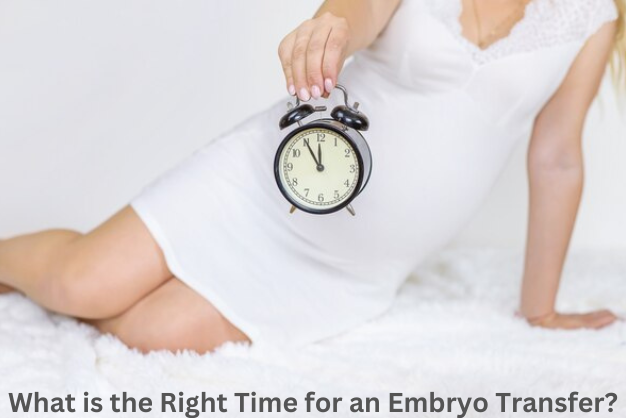What is the Right Time for an Embryo Transfer?
Understanding the intricacies of fertility treatments can be overwhelming. One of the most crucial aspects of In Vitro Fertilization (IVF) is the timing of the embryo transfer. It's a delicate dance of hormones, development, and precise calculations. In this blog post, we'll delve into the factors that influence the optimal timing for an embryo transfer and how our experts at New World Fertility Centre, Delhi, ensure the best possible outcomes for our patients.
Why Timing Matters
The success of an IVF cycle hinges on several factors, including the quality of the embryos, the receptivity of the uterine lining, and, most importantly, the synchronization of these two elements. The ideal scenario is to transfer the embryo(s) when the uterine lining is at its peak receptivity, providing the best environment for implantation.
Factors Influencing Timing
1.Embryo Development:
Day 3 Embryo Transfer: Embryos are transferred at the 8-cell stage, typically 3 days after egg retrieval. This approach is often chosen when there are a limited number of high-quality embryos.
Day 5 Embryo Transfer (Blastocyst Transfer): Embryos are cultured for 5 days until they reach the blastocyst stage. This stage is considered more mature and has a higher potential for implantation.
2. Uterine Lining:
The thickness and appearance of the uterine lining are crucial for successful implantation. Our fertility specialists monitor the lining closely using ultrasound scans and blood tests to determine the optimal time for transfer.
3. Hormonal Profile:
Hormones like estrogen and progesterone play a significant role in preparing the uterine lining. Our experts carefully monitor hormone levels to ensure they are within the ideal range for embryo transfer.
4. Individual Patient Factors:
Each patient's unique circumstances, including age, medical history, and previous IVF attempts, can influence the optimal timing for embryo transfer. Our personalized approach takes these factors into account to tailor the treatment plan accordingly.
The Role of New World Fertility Centre, Delhi
At New World Fertility Centre, Delhi, our experienced team of fertility specialists is dedicated to maximizing the chances of a successful pregnancy. We utilize advanced techniques and state-of-the-art technology to monitor your progress closely and determine the most appropriate timing for your embryo transfer.
Here's how we ensure optimal timing:
Personalized Treatment Plans: We create customized treatment plans based on your individual needs and medical history.
Advanced Monitoring: We use cutting-edge technology to monitor your hormone levels, follicle development, and uterine lining thickness.
Experienced Embryologists: Our skilled embryologists carefully culture and assess your embryos to select the best candidates for transfer.
Expert Timing: Our fertility specialists have a deep understanding of the optimal window for embryo transfer and will coordinate the procedure with precision.
Conclusion
The timing of an embryo transfer is a critical factor in IVF success. At New World Fertility Centre, Delhi, we prioritize precision and personalized care to ensure the best possible outcomes for our patients. By understanding the factors that influence timing and working closely with our experienced team, you can increase your chances of achieving your dream of parenthood.
Frequently Asked Questions (FAQs)
1. What factors determine the timing of an embryo transfer?
The timing of an embryo transfer is influenced by factors such as the quality and development stage of embryos, the health of the uterine lining, hormonal levels, and personal health conditions. A comprehensive evaluation of these factors helps specialists choose the ideal time for embryo transfer.
2. What is the difference between a Day 3 and Day 5 embryo transfer?
A Day 3 transfer occurs three days after fertilization, when the embryo has about 6-8 cells. In contrast, a Day 5 (or blastocyst) transfer happens five days post-fertilization, when the embryo is more developed. Day 5 transfers generally have higher success rates due to advanced embryo development.
3. Should I choose a fresh or frozen embryo transfer?
Fresh transfers occur shortly after fertilization, typically within 3-5 days. Frozen embryo transfers (FETs) involve cryopreserved embryos transferred at a later time, often under ideal hormonal and uterine conditions. FETs allow for better synchronization with the optimal implantation window.
4. Can an Endometrial Receptivity Analysis (ERA) improve timing?
Yes, an ERA test assesses the uterine lining’s receptivity, identifying the optimal time for embryo implantation. It is especially beneficial for those with previous unsuccessful embryo transfers, helping personalize the timing for better success.
5. Is embryo quality a factor in determining the transfer day?
Absolutely. Higher-quality embryos that develop well to the blastocyst stage (Day 5) often have a greater chance of successful implantation, making a later transfer preferable in many cases. However, Day 3 transfers may be recommended when fewer embryos are available.

 Nov-05-2024
Nov-05-2024